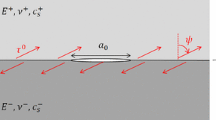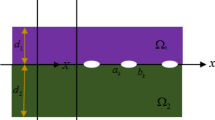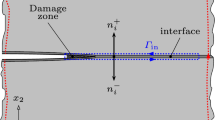Abstract
Frictional sliding on interface crack surfaces results in weak crack tip stress singularity and zero strain energy release rate. A fracture criterion based on finite extension strain energy release rate, is proposed to capture the intrinsic fracture toughness. The finite extension strain energy release rate is shown to represent the magnitude of the singular stress field. Numerical simulations of a center crack in a bimaterial infinite medium under remote shear as well as fiber pull-out and push-out in composite materials are presented to illustrate the frictional effect in both small and large scale contacts near the crack tip.
Similar content being viewed by others
References
Atkinson, C., Avila, J., Betz, E. and Smelser, R.E. (1982). The rod pull–out problem, theory and experiment. Journal of Mechanical and Physical Solids 30(3), 97–120.
Buchholz, F.G., Wang, H., Ding, S. and Rikards, R. (1995). Delamination analysis for cross–ply laminates under bending with consideration of crack face contact and friction. Proceedings of the 10th International Conference on Composite Materials (ICCM–10)1, Whistler, BC, Canada, August 14–18, 141–148.
Comninou, M. (1977). Interface crack with friction in the contact zone. Journal of AppliedMechanics 44, 780–781.
Comninou, M. and Dundurs, J. (1980). Effect of friction on the interface crack loaded in shear. Journal of Elasticity 10(2), 203–212.
Deng, X. (1994). An asymptotic analysis of stationary and moving cracks with frictional contact along bimaterial interfaces and in homogeneous solids. International Journal of Solids and Structures 31(17), 2407–2429.
Deng, X. (1995). Mechanics of debonding and delamination in composites: Asymptotic studies. Composites Engineering 5(11), 1299–1315.
Gao, C.Y., Mai, Y.W. and Cotterell, B. (1988). Fracture of fiber reinforced materials. Journal of Applied Mathematics and Physics (ZAMP) 39, 550–572.
Hutchinson, J.W. and Jensen, H.M. (1990). Models of fiber debonding and pullout in brittle composites with friction. Mechanics of Materials 9, 139–163.
Kerans, R.J. and Parthasarathy, T.A. (1991). Theoretical analysis of the fiber pullout and pushout tests. Journal of the American Ceramics Society 74, 1585–1596.
Qian, W. and Sun, C.T. (1998). Frictional interfacial crack under combined shear and compressive loading. Composites Science and Technology 58, 1753–1761.
Sigl, L.S. and Evans, A.G. (1989). Effects of residual stress and frictional sliding on cracking and pullout in brittle matrix composites. Mechanics of Materials 8, 1–12.
Stringfellow, R.G. and Freund, L.B. (1993). The effect of interfacial friction on the buckle–driven spontaneous delamination of a compressed thin film. International Journal of Solids and Structures 30(10), 1379–1395.
Sun, C.T. and Qian, W. (1997). The use of finite extension strain energy release rates for fracture in interface cracks. International Journal of Solids and Structures 34(20), 2595–2609.
Author information
Authors and Affiliations
Rights and permissions
About this article
Cite this article
Sun, C., Qian, W. A treatment of interfacial cracks in the presence of friction. International Journal of Fracture 94, 371–382 (1998). https://doi.org/10.1023/A:1007526830000
Issue Date:
DOI: https://doi.org/10.1023/A:1007526830000




